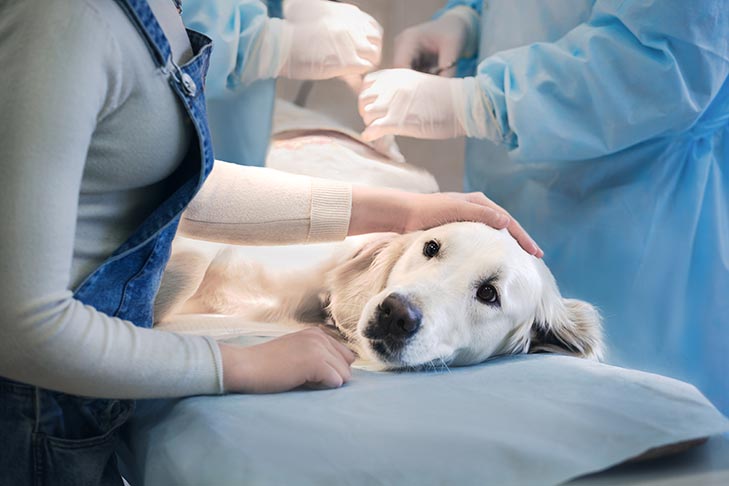Paralysis can happen not just to humans but to dogs, too. Defined as an inability to voluntarily move parts of your body, having a dog with sudden paralysis can be scary for both of you. Similarly, if your dog is paralyzed long-term, there will likely be changes in your life as you knew it. While sudden paralysis is an emergency, it’s one you must approach calmly. Here’s what to know about symptoms and causes of canine paralysis, as well as what steps to take if you think your dog may be paralyzed.
Symptoms of Paralysis in Dogs
Symptoms of paralysis, which may depend on the cause, can include:
- Full or partial inability to move legs
- Dragging back legs
- Stiff-legged gait
- Lack of coordination
- Inability to urinate
- Incontinence
- Limping
- Vomiting
- Change in the sound of their barking
- General weakness
- Muscle loss or shrinkage
- Reluctance to jump
- Walking with a hunched back
- Shivering
- Panting
- Refusal to eat
- Neck pain
- Shaking

Causes of Dog Paralysis
Many conditions can cause paralysis in dogs. If your dog is experiencing symptoms, it could be due to underlying causes or other conditions. These can range from systemic causes (caused by ticks, bacteria, or viruses), trauma or injury, or hereditary causes. If you suspect that your dog is affected by paralysis for any reason, reach out to your vet or emergency clinic as soon as possible.
Systemic Causes of Paralysis in Dogs
Paralysis in dogs from general illness is more common than most people think. Diseases caused by toxins, bacteria, viruses, fungi, or immune reactions can sometimes lead to paralysis in dogs. Inflammatory and infectious diseases can cause the spinal cord to swell. Some of these include canine distemper, Rocky Mountain spotted fever, ehrlichiosis, granulomatous meningoencephalomyelitis, toxoplasmosis, and fungal diseases such as cryptococcus, blastomycosis, and histoplasmosis. Rarely, tetanus may cause paralysis in dogs.
If dogs are severely exposed to pesticides that ingredients called organophosphates, they can experience what is called organophosphate intoxication. The Centers for Disease Control defines organophosphates as human-made chemicals that poison insects and mammals. Symptoms of this type of chemical intoxication may include paralysis. Most commonly, tick bite and coonhound paralysis are linked to systemic paralysis in dogs.
- Tick bite paralysis: One of the most common types of paralysis in dogs occurs when ticks bite dogs. Ticks can inject what is called a neurotoxin, which some dogs react to by gradually becoming paralyzed. The condition may start with a lack of coordination and slowly progress over about a week to total paralysis. Associated signs can include vomiting or a change in the sound of your dog’s barking. If your dog’s symptoms fit this description, look everywhere on your dog for a tick or evidence of a tick bite. This may require shaving your dog’s coat down or bringing your dog to your vet for an exam.

- Coonhound paralysis: Officially known as acute canine idiopathic polyradiculoneuritis (ACIP), coonhound paralysis is traditionally associated with exposure to raccoon saliva, but dogs that have never been near a raccoon have also contracted the disease. According to a study from the American College of Veterinary Internal Medicine, the cause of coonhound paralysis may be the bacteria Campylobacter, which has also been flagged as a cause of human Guillain-Barré syndrome (GBS). GBS has a similar process to coonhound paralysis, where the immune system starts attacking nerve coatings. Paralysis begins about a week after exposure, starting with generalized weakness and a stiff-legged gait in the rear. No medication is currently available for the treatment of coonhound paralysis. But with good nursing care, most dogs recover within weeks. In serious cases, the condition may worsen and become so severe that all four legs (but usually not the tail) may become paralyzed. The muscles may shrink, and some dogs vomit. Some dogs lose their voices. If the muscles of the face are affected, your dog may not be able to blink, and their eyes will dry out. If the muscles in the chest that control breathing become paralyzed, your dog may die unless they’re placed on a ventilator.
Spinal Column Injury or Trauma and Dog Paralysis
Traumatic injury or disease of the spinal column can also cause paralysis in dogs. The spinal cord is the main bundle of nerves that allows the brain to communicate with the rest of the body. It is protected by flexible spinal bones or vertebrae. Between each vertebra are cushioning intervertebral disks, soft pods of jelly-like material surrounded by a tough layer. If damage to the disks or vertebra occurs, it can damage the spinal cord.
- Spinal cord trauma: Motor vehicle accidents are the top cause of spinal cord injuries in dogs. Accidents that result in damage to the spinal cord may cause bruising and swelling. When trauma occurs here, dogs may recover once the swelling goes down. Some slight damage to the cord could repair itself, but more extensive damage will not. Sometimes dogs may seem fine after trauma or may just limp a bit, but when the spinal cord is jostled, it causes further injury. If your dog is ever in an accident, it’s important to stabilize the back and neck just like you would with a person. Use a stiff board to carry your dog and seek immediate veterinary attention. Your veterinarian will diagnose the extent of the injury, and treat it with relevant medications targeting pain and swelling.

- Intervertebral Disk Disease (IVDD): This is most often seen in dogs with shorter legs. People used to think IVDD occurred because the back was so long, but more recent studies have shown that some, but not all, dwarfism genes that cause short legs also cause the jelly-like inner part of the disk to harden. That process can start when your dog is as young as one year old. When these disks harden, it can lead to different types of IVDD and eventually even paralysis.
- Hansen Type I: When the inner part of the disk hardens, the rigid disk doesn’t flex the way it should. As a result, the disk can break open, allowing the hardened contents to squeeze out. Even though the contents harden gradually, the final collapse usually occurs suddenly, sometimes when a dog is running or jumping. This final collapse can put pressure on the spinal cord, which may then result in pain or paralysis. This type of disk collapse is called a Hansen Type I herniation. The gene responsible for the hardened disk is associated with a type of dwarfism called chondrodysplasia, found in breeds such as the Pembroke Welsh Corgi and Dachshund. However, it is not associated with other breeds, such as Beagles and French Bulldogs that have also been classified as chondrodysplastic dwarves.
- Hansen Type II: Another type of IVDD, Hansen Type II herniation occurs mostly in large breeds such as German Shepherd Dogs and Labrador Retrievers. This is usually a gradual process. With this condition, the thick fibers around the soft disk material slowly collapse, eventually allowing the contents to bulge and leak out of the disk. When they push against the spinal cord, it can cause pain and paralysis. At first, dogs may just limp or be hesitant to jump. Because it can also be painful, dogs may walk with a hunched back, or they may shiver, pant, or refuse to eat. In either case, your veterinarian may be able to help your dog by prescribing medications to reduce pain and swelling. Your dog will need strict crate rest to have the best chance at recovery. In more severe cases, surgery may be needed to remove the pressure from the spinal cord. Even so, surgery may not always be successful, especially in dogs that can no longer feel pain because of paralysis.

- Spinal “stroke”: This term is often casually used to refer to two spinal cord conditions that have similar signs. Both conditions occur most often in middle-aged or older dogs that are medium in size, as well as in Miniature Schnauzers and Shetland Sheepdogs. One condition is a fibrocartilaginous embolism (FCE), in which a tiny piece of intervertebral disk breaks off and blocks the blood flow to part of the spinal cord. Another condition is technically known as an acute non-compressive nucleus pulposus extrusion (ANNPE), in which the disk explodes and shoots out its contents with such force that it bruises the spinal cord. Both of these conditions usually occur suddenly when your dog is running or jumping. Your dog can often recover from both on their own, but many require medications for pain and swelling, as well as rehabilitation.
- Tumors: Tumors of the nerves and surrounding areas can push upon the spinal cord, causing paralysis. Your vet may recommend surgery as a treatment option in this instance, but tumors can also be signs of other conditions. If you suspect that your dog may have a tumor, you should always check with your vet.
Hereditary and Possibly Hereditary Causes of Dog Paralysis
Researchers also suspect some nervous system (neural) disorders that result in paralysis may be hereditary. These disorders tend to affect dogs belonging to a particular breed.
- Degenerative myelopathy (DM): This hereditary condition affects many different dog breeds and mixed-breed dogs. Signs, which begin with weakness and incoordination of the hind limbs, start in late middle age. The weakness progresses to hind-leg paralysis. Then the paralysis gradually progresses forward toward the forelimbs and finally, neck and head. At this time, no treatment is available.
- Cervical spondylomyelopathy: Popularly known as Wobbler syndrome, two forms of cervical spondylomyelopathy exist. Disk-associated Wobbler syndrome (DAWS) mostly affects older, middle-aged dogs belonging to large breeds, including Doberman Pinschers. Bony-associated compression mostly affects young, giant-breed dogs. Signs include weakness or uncoordinated gait and neck pain. Surgery can help most affected dogs.

- Spinal muscular atrophy: This hereditary condition affects dogs including Brittanys, Pointers, German Shepherd Dogs, Doberman Pinschers, and Rottweilers. It begins at a young age, and symptoms include shaking, muscle loss, and weakness.
- Lumbosacral transitional vertebra: This condition is considered hereditary and results from a malformed spinal vertebra. Lumbosacral transitional vertebra occurs most often in German Shepherd Dogs.
- Degenerative Lumbosacral Stenosis: It’s not clear whether degenerative lumbosacral stenosis is hereditary. This condition occurs when nerves in the lower back are compressed for an unknown reason. It’s most common in large breeds, especially German Shepherd Dogs. Affected dogs may have hind leg and tail weakness and incontinence, and they may feel pain when you touch their lower back. Surgery is usually successful.
What to Do if Your Dog Appears to Be Suddenly Paralyzed
Sudden paralysis in your dog can be scary for both of you. If your dog appears to be paralyzed, either partially or fully, the first thing to do is try to keep your dog as calm as possible. Remove any dangers around them, as well as any dogs from the area. Even normally friendly dogs can become confused by a suddenly paralyzed dog and attack them, especially if they’re yelping.
Call your veterinarian, emergency vet clinic, closest veterinary school, or small animal clinic right away and proceed as they direct. Follow their advice on how to move your dog or ask if there is an ambulatory service.

Do not administer any drugs to your dog. Depending on what is causing this sudden paralysis, any drugs, including medications or painkillers, could potentially do more harm than good. Wait for your vet, who will determine the cause and administer medication if appropriate.
Sometimes, injury can cause paralysis. If this seems to be the case, move your dog onto a solid backboard, like a plank or piece of plywood. Alternatives could be things like a doggy gate, folded crate, or lightweight table. This should be something that you can carry if needed, that can hold the weight of your dog.
Make sure that aside from keeping your dog calm, you are doing your best to stay calm as well. Sudden paralysis is an emergency, but it’s not one where milliseconds usually count. Doing things safely and carefully is always a better option than doing them hurriedly.
While some types of canine paralysis may be permanent, many more types may be temporary or treatable. It all depends on what caused it, and how your vet decides to treat it.
Diagnosing Dog Paralysis
Your veterinarian may need to perform several tests to discover what is causing your dog’s paralysis. They will conduct a physical exam and see which of your dog’s legs can move, feel pain, or show proper reflexes. They will also examine whether your pet can feel when their paw is placed down incorrectly. Your vet may search your dog thoroughly for ticks to determine if the cause is tick bite or coonhound paralysis.
To find out if your dog may have been poisoned or injured, the vet will need information about whether the paralysis came on gradually or suddenly. They’ll also need your dog’s detailed medical history. Information about your dog’s size and breed can be important in narrowing down the possible causes.

Blood tests may rule out various bacterial, fungal, and viral diseases, while your vet may use various types of imaging for diagnostic purposes. Radiographs (X-rays) help see any injuries. Magnetic resonance imaging (MRI) or computed tomography (CT) can be helpful in deciding between IVDD, spinal stroke, and other disorders as the diagnosis. A myelogram may allow evidence of nerve impulses to be visualized.
Treatment of Dog Paralysis
Treatment will depend on the cause and extent of your dog’s paralysis. Initial treatment may need to take place in the veterinary hospital, especially if your dog cannot walk, urinate, or defecate on their own. Your vet may prescribe medications for pain, swelling, or infections, and perform surgery. In addition to traditional techniques, some veterinary hospitals provide complementary or holistic treatments, including acupuncture for dogs, hyperbaric chamber treatments, underwater treadmills, and other forms of physical rehabilitation.
Once home, follow your vet’s discharge instructions. For some dogs, this will mean complete crate rest for a long time. Although a paralyzed dog won’t be able to move, they can still feel discomfort. Check to make sure no external factors, like a crate digging into your dog’s side, could be causing them pain, especially because they can’t move away. For others, it may mean performing rehabilitation exercises. Some dogs will improve quickly, others slowly. Unfortunately, some dogs may never improve to the point of walking on their own again.

Caring for a Paralyzed Dog
Caring for a dog with partial or full paralysis does come with challenges. You may need to learn how to empty your dog’s bladder manually. You or a veterinarian may need to turn your dog to prevent bed sores and empty their bladder with a catheter. You may need to decide if using a canine wheelchair is the answer for your dog. While many wheelchair-bound dogs live fun and adventurous lives, maneuvering a dog (especially a large one) in and out of a chair may not be possible for every owner.
When it comes to paralysis, no two dogs, and no two situations, are the same. But knowing the cause will give your dog the best chance of getting back on their feet.








